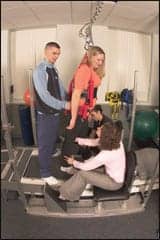Diaphragm pacing (DP) stimulation in spinal cord-injured patients may successfully wean patients from mechanical ventilators and also bridge patients to independent respiration, without the aid of a ventilator or stimulation, a recent study reports.
In a news release, University Hospitals Case Medical Center states that the stimulation is facilitated by the Diaphragm Pacing System (DPS), technology engineered to provide electrical stimulation to nerves running through the diaphragm. Once stimulated, the diaphragm then contracts to allow patients to breath more naturally than having air forced into the lungs, as is the case with a mechanical ventilator. According to the release, the system is implanted through minimally invasive laparoscopic surgery.
During the study, researchers assessed the records of 29 patients with an average age of 31 years, at 16 hospitals in the US where DP implantation is approved. The researchers state that elapsed time from injury to surgery was 40 days. The study’s goal reportedly centered on determining if earlier testing and DP provided benefit.
The results indicate that among patients whose diaphragm muscles responded to stimulation, 72% were completely free of ventilator support in an average of 10 days. Among the remaining six patients, researchers say, two exhibited a delayed weaning of 6 months, three had partial weans using DP at times during the day. One successfully implanted patient also went on to a long-term acute care hospital and subsequently had life-prolonging measures withdrawn, the release states. A total of seven of the 29 patients were found to have non-stimulatable diaphragms from nerve damage. A total of 36% had complete recovery of respiration and DP wires were removed, the researchers explain.
DPS inventor and study author Raymond Onders, MD, of University Hospitals (UH) Case Medical Center, states that the study’s results offer key observations, “Most notably, laparoscopic diaphragm mapping—an electronic reading of the diaphragm nerves—is safe and can be performed in multiple centers with success. In addition, early diaphragm mapping can quickly determine if a phrenic nerve injury is complete, allowing for early ventilator planning and prevention of weaning trials if we find the patient will not be able to be weaned from the ventilator. Finally, DP can successfully wean traumatic cervical SCI patients as evidenced by 72 percent of the implanted patients being completely weaned from ventilators and 36% with complete recovery and DP removal.”
Onders goes on to designate DP as a major step in improving the life of spinal cord injury (SCI) patients who cannot breathe without the help of a ventilator. The release notes that DPS has also been approved for patients with amyotrophic lateral sclerosis (ALS) and is currently being used in patients with other conditions as well.
Source: University Hospitals Case Medical Center





